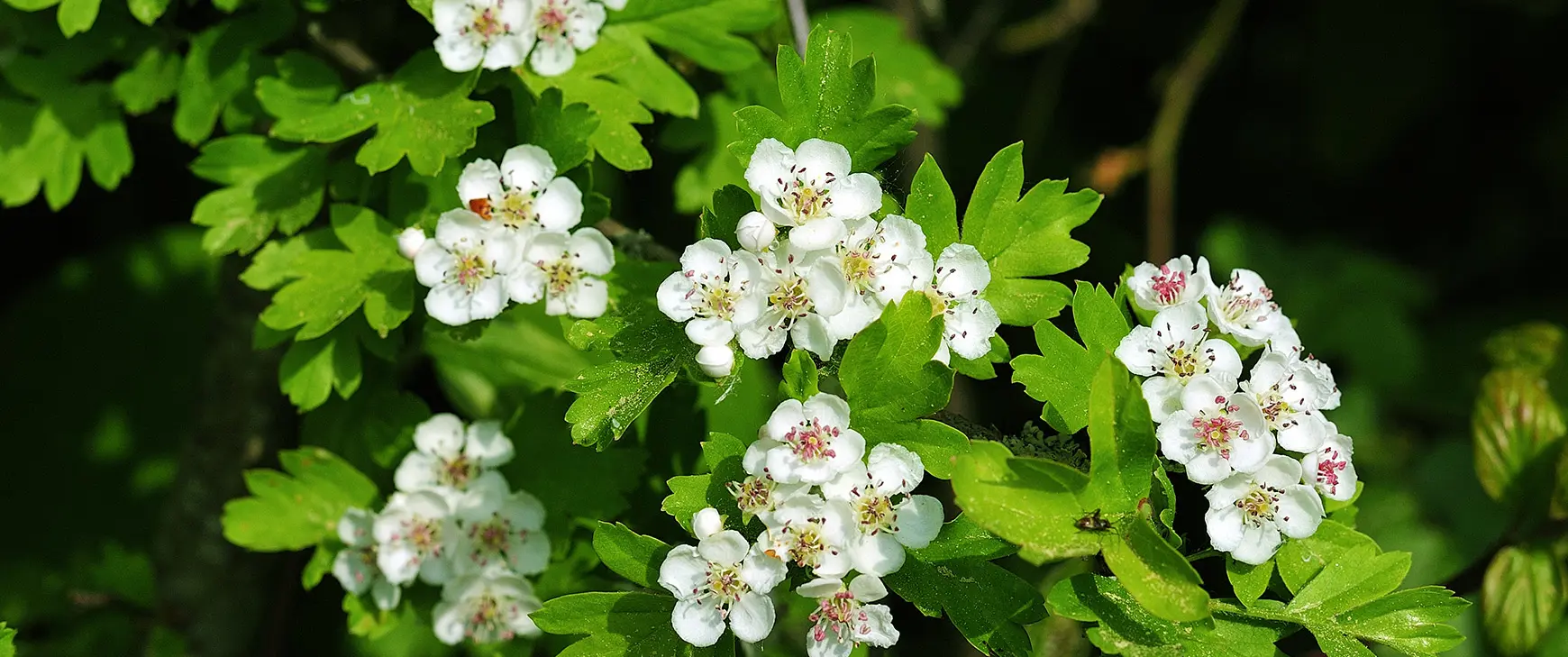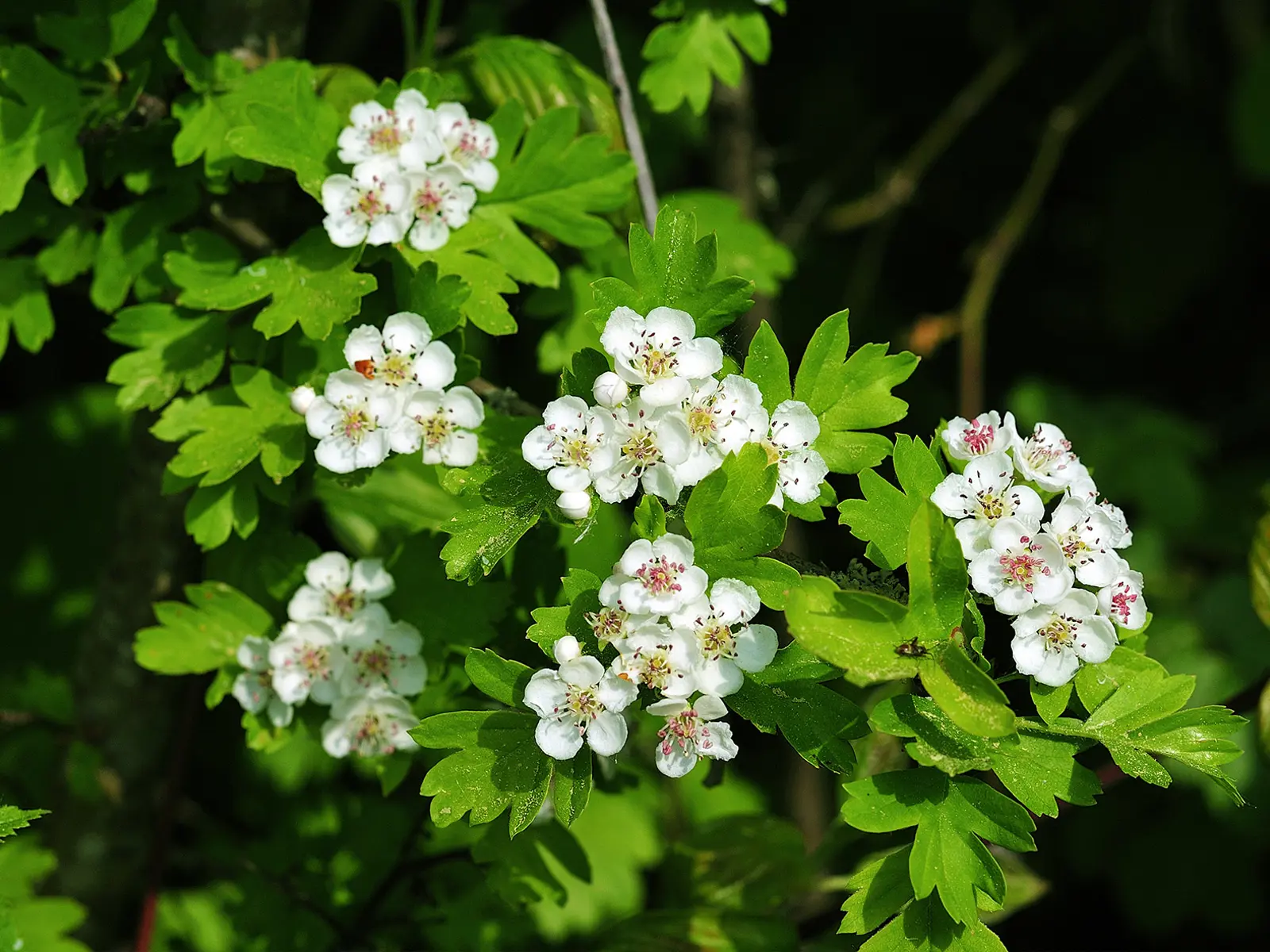
Hawthorn (Crataegus sp.)
Hawthorn trees and bushes are native to Switzerland and often found in forests, water meadows and gardens. Hawthorn is traditionally used to treat temporary nervous cardiac conditions.
Hawthorn has white flowers and red berries, and can often be found in gardens featuring local plants. The white flowers are popular among honey bees and wild bees. In winter, birds feed on the red berries and use the thorny bushes as shelters for their nests. Hawthorn is traditionally used to treat temporary nervous cardiac conditions, minor stress symptoms and as a sleeping aid. This article will tell you more about where hawthorn can be found as well as its distribution, appearance, history and use.
Occurrence and distribution of hawthorn
Hawthorn belongs to the rose family (Rosaceae) which is part of the genus Crataegus. Two species are native to Switzerland: common hawthorn or quickthorn (Crataegus monogyna Jacq. ) and midland hawthorn (Crataegus laevigata (Poir.) DC.). Given that the different varieties of hawthorn can cross-breed, lay people can find it difficult to identify individual species.
Hawthorn is widespread in Central Europe and here in Switzerland. It prefers loamy, calcareous soil and sunny to semi-shady locations. It can often be found on the edge of deciduous forests and in thickets, shrubberies and hedgerows. In gardens, hawthorn is typically planted to form natural hedges. Various butterfly caterpillars feed on hawthorn leaves. In May and June, the flowers serve as important bee pastures and in winter the red berries provide food for local bird species. Birds eat the berries and excrete the seeds, thereby helping the plant to spread. Hawthorn shrubs are also favoured breeding sites for songbirds because the thick branches and thorns protect their nests from unwanted visitors.
Appearance of hawthorn
Hawthorn grows as a shrub or small tree. It typically grows up to five metres high, but can occasionally be as high as ten metres. The leaves are around six centimetres long and have toothed edges. The stem features many branches and is covered with thorns. In May and June the shrubs produce white flowers with five petals, which are arranged in corymbs. The dark red berries begin ripening in September.
History and tradition of hawthorn
There are many different regional names for hawthorn. Crataegus monogyna is also known as “maythorn” and “mayblossom” as its flowers are produced in late spring (May to early June). Its scientific name “Crataegus” means “strong” or “powerful”. This refers to the plant’s hard wood.
During difficult times, such as the first and second world wars, common hawthorn leaves were used as a replacement for tea leaves. The seeds were also finely ground and used to brew coffee. Even the edible berries were used as a purée or flour to enrich people’s meagre diets.
Hawthorn’s active ingredients
The leaves, flowers and berries of various types of native European hawthorn are used for medicinal purposes. They can be found in many herbal tablets and drops. The main components of hawthorn leaves and blossom are:
- flavonoids, generally present as glycosides (for example vitexin, isovitexin, hyperoside and quercetin)
- flavanes (for example (+)-catechin, (-)-epicatechin, oligomers and polymeric proanthocyanidins)
- triterpene acids (for example crataegus acid, ursolic acid and oleanolic acid)
- organic acids (for example caffeic acid and chlorogenic acid)
- other active ingredients (for example purine derivatives and minerals)
Hawthorn as a medicinal product
Hawthorn leaves and blossom traditionally take the form of a herbal infusion or a powder form; they may also take the form of a liquid or dry extract.
Hawthorn leaves and blossom are traditionally used to alleviate symptoms of temporary nervous cardiac conditions after serious cardiac conditions have been ruled out by doctors. Nervous heart conditions can appear as cardiac palpitations or an irregular heart rhythm.
Preparations made from hawthorn leaves and blossom are also traditionally used to alleviate mild stress symptoms and as a sleeping aid.
This is general information. For individual advice, please contact a specialist.
Modern herbal medicine
Modern herbal medicine (phytotherapy) combines centuries-old knowledge with the latest scientific findings.
DetailsModern herbal medicine
Modern herbal medicine (phytotherapy) combines centuries-old knowledge with the latest scientific findings.
Details
